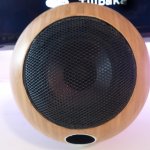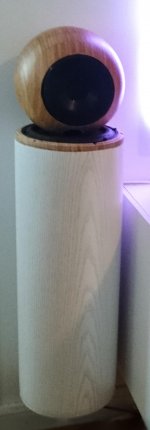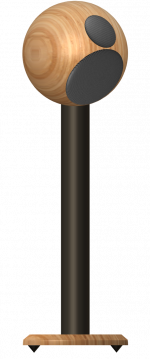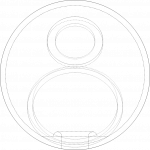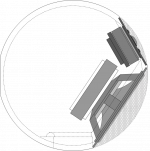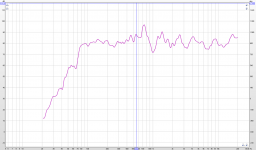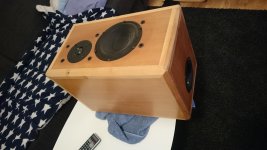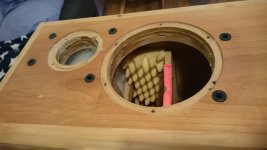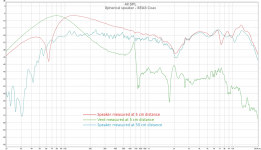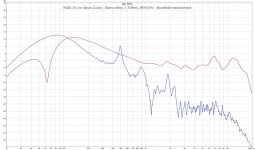The prototype
The Seas coax pumps a lot of air
 .
.
After a lot of tests and meauserments I had to recalculate...
Nothing else to expect in a small enclosure . I had to go for dia. 36 mm and 324 mm long. This affected of course the volume which now is 2,2 liters.
The fB is still set to 63 Hz but the f-3dB went up to 80 Hz. It seems ok when calculating and with the impedance correction it should give a pretty flat curve but measurements are of course needed to verify and trim the filter.
I also had a hearable overtone from the vent at 435 Hz which hopefully may be gone, else some other damping must be used in the enclosure.
I think thes will perfect in combination to a bass module or as surround speakers. To be coninued...
The Seas coax pumps a lot of air
After a lot of tests and meauserments I had to recalculate...
Nothing else to expect in a small enclosure . I had to go for dia. 36 mm and 324 mm long. This affected of course the volume which now is 2,2 liters.
The fB is still set to 63 Hz but the f-3dB went up to 80 Hz. It seems ok when calculating and with the impedance correction it should give a pretty flat curve but measurements are of course needed to verify and trim the filter.
I also had a hearable overtone from the vent at 435 Hz which hopefully may be gone, else some other damping must be used in the enclosure.
I think thes will perfect in combination to a bass module or as surround speakers. To be coninued...
Attachments
Seas coax result
The changes made an improvement. Still breathes heavily but the air speed is down to accepable levels (no distorsion) and with some filling the speaker is also better controlled. The sound is now better balanced after further damping of the tweeter. There are no sounding/vibrations from the cabinet (thin layer of low density glue/silicon and damping wool inside) nor any hearable overtones. It playes lively and clean with quite low bass (well it's tuned to 63 Hz but for a small cabinet like this...).
I will measure it when I get some time over. If it ends up good, four will be built as surround speakers. This prototype may be changed again to be tested as mid/high speaker combined with a bass module prototype I've just pu together using the old but great Scan-Speak 18W/8545 in a14 litres cylinder shaped enclosure. Will most likely be crossed over somewhere at 120 Hz depending on the result when playable/measurable. Nice combination though since both enclosures have a diameter of 200 mm. See picture.
The changes made an improvement. Still breathes heavily but the air speed is down to accepable levels (no distorsion) and with some filling the speaker is also better controlled. The sound is now better balanced after further damping of the tweeter. There are no sounding/vibrations from the cabinet (thin layer of low density glue/silicon and damping wool inside) nor any hearable overtones. It playes lively and clean with quite low bass (well it's tuned to 63 Hz but for a small cabinet like this...).
I will measure it when I get some time over. If it ends up good, four will be built as surround speakers. This prototype may be changed again to be tested as mid/high speaker combined with a bass module prototype I've just pu together using the old but great Scan-Speak 18W/8545 in a14 litres cylinder shaped enclosure. Will most likely be crossed over somewhere at 120 Hz depending on the result when playable/measurable. Nice combination though since both enclosures have a diameter of 200 mm. See picture.
Attachments
Another bowl idea
Just got an idea since I have a couple of Scan-Speak elements to no use for the moment. I'm going to test the woofer (18W/8545) and the tweeter (D2905/9300000) in a 28 cm IKEA bowl.
With a vent with dia. 6,7 cm and 67 cm long gives fB 45 Hz and f-3 63 Hz (flat response) out of 7,45 litres.
I know it is far from optimal and most likely there will be a need of reconstruct after measuring and probably increase the fB to maybe 55 Hz but it gives far more output than the smaller bowl with the small Seas coax.
It will also be of interest to find out how the angles of the woofer and tweeter affects the sound in the room and in the listening position.
The other solution is of course to increase the volume but I would like to test this. The bass below needs to be complemented with a bass module.
Attached are the idea. I will see when I have some time over, as always.
Just got an idea since I have a couple of Scan-Speak elements to no use for the moment. I'm going to test the woofer (18W/8545) and the tweeter (D2905/9300000) in a 28 cm IKEA bowl.
With a vent with dia. 6,7 cm and 67 cm long gives fB 45 Hz and f-3 63 Hz (flat response) out of 7,45 litres.
I know it is far from optimal and most likely there will be a need of reconstruct after measuring and probably increase the fB to maybe 55 Hz but it gives far more output than the smaller bowl with the small Seas coax.
It will also be of interest to find out how the angles of the woofer and tweeter affects the sound in the room and in the listening position.
The other solution is of course to increase the volume but I would like to test this. The bass below needs to be complemented with a bass module.
Attached are the idea. I will see when I have some time over, as always.
Attachments
Just got an idea since I have a couple of Scan-Speak elements to no use for the moment. I'm going to test the woofer (18W/8545) and the tweeter (D2905/9300000) in a 28 cm IKEA bowl.
With a vent with dia. 6,7 cm and 67 cm long gives fB 45 Hz and f-3 63 Hz (flat response) out of 7,45 litres.
I know it is far from optimal and most likely there will be a need of reconstruct after measuring and probably increase the fB to maybe 55 Hz but it gives far more output than the smaller bowl with the small Seas coax.
It will also be of interest to find out how the angles of the woofer and tweeter affects the sound in the room and in the listening position.
The other solution is of course to increase the volume but I would like to test this. The bass below needs to be complemented with a bass module.
Attached are the idea. I will see when I have some time over, as always.
Another DIY experiment as inspiration:
HIFI4ALL Forum: Højtalere fordi det er sjovt.
KrammeAcoustic, thank you. I could never get enough of inspiration.
I don't know why but the small with Seas coax I tested sounds beter and better. Might be that the spherical enclosure fits my room acoustic as well. Anyway, I'm going to find out as much as possible about spherical enclosures, pros and cons. Once again, thanks for the link.
I don't know why but the small with Seas coax I tested sounds beter and better. Might be that the spherical enclosure fits my room acoustic as well. Anyway, I'm going to find out as much as possible about spherical enclosures, pros and cons. Once again, thanks for the link.
Another DIY experiment as inspiration:
HIFI4ALL Forum: Højtalere fordi det er sjovt.
KrammeAcoustic,
I have tried the small bowl with a tweeter but on top of another speaker. I don't know why but I was not satisfied with the sound. It might be that my tweeter had a big mounting plate covering almost the full diameter compared to your solution, giving a big sphere for the tweeter as well. However, I never tested mine together with a bigger bowl as your great solution but I sure will and maybe I can replace my mounting plate with a small one. How is your experience (phase, diffraction etc)?
Great idea and high class work!
KrammeAcoustic,
I have tried the small bowl with a tweeter but on top of another speaker. I don't know why but I was not satisfied with the sound. It might be that my tweeter had a big mounting plate covering almost the full diameter compared to your solution, giving a big sphere for the tweeter as well. However, I never tested mine together with a bigger bowl as your great solution but I sure will and maybe I can replace my mounting plate with a small one. How is your experience (phase, diffraction etc)?
Great idea and high class work!
After meil made some back in 2008, i also did the same about a year later ...but i wasn't satisfied with the sound of them. I were using some 3 inch coaxial units ( car speakers ...sorry don't remember the name of them ). But i remember doing some phaseinverting of the tweeter ...it helped a bit for the hiss sound. Later the tweeter was removed and they actually sounded better just as a stand alone fullrange without filtering. Later one of my friends got them, maybe he still use them as rear speakers in his surround setup. He was satisfied with them.
About the phaseinverting of the tweeter, it had a very ugly peak at 10 khz as standard ...but when it was inverted the peak was gone. If both units fullrange + tweeter has a peak in the same frequence area, it will help by inverting one of them. By doing so, the units help eachother to eliminate the peak.
About diffraction, the unit won't see a baffle so it's a bit special. Still i guess you should try some filtering to get satisfied.
Note: the picture of the small bowls+big bowls was never made, it was just done in PSP for inspirational use.
Bohusbusen, good luck with the project.
Last edited:
After meil made some back in 2008, i also did the same about a year later ...but i wasn't satisfied with the sound of them. I were using some 3 inch coaxial units ( car speakers ...sorry don't remember the name of them ). But i remember doing some phaseinverting of the tweeter ...it helped a bit for the hiss sound. Later the tweeter was removed and they actually sounded better just as a stand alone fullrange without filtering. Later one of my friends got them, maybe he still use them as rear speakers in his surround setup. He was satisfied with them.
About diffraction, the unit won't see a baffle so it's a bit special. Still i guess you should try some filtering to get satisfied.
Note: the picture of the small bowls+big bowls was never made, it was just done in PSP for inspirational use.
Bohusbusen, good luck with the project.
I also tried to shift phase, but that turned out worse since the filter was built with phase in mind... I guess I'll just give your iodea a try, else I'll go for mine. Listening, measuring and rebuilding until I'm satisfied or I'll scrap idea.
Thank you for supporting with inputs, much appreciated!
I also tried to shift phase, but that turned out worse since the filter was built with phase in mind... I guess I'll just give your iodea a try, else I'll go for mine. Listening, measuring and rebuilding until I'm satisfied or I'll scrap idea.
Thank you for supporting with inputs, much appreciated!
Velbekomme kære nabo 😉
A measured (and hearable) problem
Anyone knows howe to deal with this dilemma. It's hearable 🙁. What if the port is facing down or ends up in the rear or is it just possible with a bigger diameter of the vent if I want to keep the tuning frequency?
Made a quick measurment (using REW) 1m in front of the speaker which shows a problem caused by the port between 600-1000Hz (See pic.).I will measure it when I get some time over.
Anyone knows howe to deal with this dilemma. It's hearable 🙁. What if the port is facing down or ends up in the rear or is it just possible with a bigger diameter of the vent if I want to keep the tuning frequency?
Attachments
Last edited:
I have now realixed that the meauserments are made by a bad microphone (same results on four different speakers) and have ordered a new microphone. Hopefully the results turns out to the better 🙂
New speaker
Hopefully I will get some time to make the bigger IKEA bowls (28 cm) with the speakers I have in my old not used speakers (see pic) as a test. I doubt the Scan-Speak 18W/8545 will like this and if not those will be good in two smaller tube subwoofers for my father and I will try with either the Scan-Speak 8430 woofer or some of the Seas woofers. Else a totally new tube with the speakers mounted on side (not the end of the tube) which also saves some space and has been prooved to be good from a sound point of view. I'll do this as a hobby and it have to take the time needed since both my work and family takes most of the time and I rarely got the chance to build and listen anymore...like many others of you out there 😛
Hopefully I will get some time to make the bigger IKEA bowls (28 cm) with the speakers I have in my old not used speakers (see pic) as a test. I doubt the Scan-Speak 18W/8545 will like this and if not those will be good in two smaller tube subwoofers for my father and I will try with either the Scan-Speak 8430 woofer or some of the Seas woofers. Else a totally new tube with the speakers mounted on side (not the end of the tube) which also saves some space and has been prooved to be good from a sound point of view. I'll do this as a hobby and it have to take the time needed since both my work and family takes most of the time and I rarely got the chance to build and listen anymore...like many others of you out there 😛
Attachments
Last edited:
I have now realized that the meauserments are made by a bad microphone...
What is that mic that you believe it doesn't work right?
It is a Dayton UMM-6. However, I cancelled the order for a new mic since I found out that the calibration file was corrupt. I downloaded a new one for my mic and the result is totally different.What is that mic that you believe it doesn't work right?
I've mad new measurments where I realized the fB was wrong - 56 Hz instead of calculated 63 Hz. I had to shorten the vent and the result is much better!
Not only the measurments looks better (Attached pic.), it sounds better and the hearable overtone from the vent is gone even though it's still measured as quite big.
Well, it seems that the only thing left is to adjust the filter to remove the dip at crossover (2 kHz) and then build four of these as surround.
I might try it out with a larger and of course longer vent, used as a stand as the plan is for the bigger bowl I plan to build. Two bigger as front speakers and four as surround. Need to build something similar for the center as well. After that I need to continue find a good solution for the roof speakers (Atmos)...I have to do this for a long time 🙄
Attachments
Final version
After measuring and listening it was decided that the four spherical surround speakers will have the vent facing the wall, slightly downwards. This will of course help the low end but when meausering it shows this is a less good solution. However, it sounds better with a more balanced bass but also a tighter bass so the decision was easy. I have attached a picture showing the difference between the two vent placements.
Also the dip at crossover (2kHz) that I had earlier is gone after changing polarity of the tweeter.
The filter (not showned in picture) is placed in the enclosure around the vent so the remaining volume is approx. 1,8 liters (tuned to 63 Hz). I'm impressed how deep (relatively), clear and balanced this small speaker sounds. Now I can throw my crappy Boston Soundware S system I used as surround. Well, it does not sounds that bad but not good either and they reach only 150 Hz before failing. The speaker and filter quality was cheaper than I could imagine (see pic).
After I finished these four I will start with the bigger bowls (9 liters left after speakers and filter are installed) tuned to 42 Hz.
After measuring and listening it was decided that the four spherical surround speakers will have the vent facing the wall, slightly downwards. This will of course help the low end but when meausering it shows this is a less good solution. However, it sounds better with a more balanced bass but also a tighter bass so the decision was easy. I have attached a picture showing the difference between the two vent placements.
Also the dip at crossover (2kHz) that I had earlier is gone after changing polarity of the tweeter.
The filter (not showned in picture) is placed in the enclosure around the vent so the remaining volume is approx. 1,8 liters (tuned to 63 Hz). I'm impressed how deep (relatively), clear and balanced this small speaker sounds. Now I can throw my crappy Boston Soundware S system I used as surround. Well, it does not sounds that bad but not good either and they reach only 150 Hz before failing. The speaker and filter quality was cheaper than I could imagine (see pic).
After I finished these four I will start with the bigger bowls (9 liters left after speakers and filter are installed) tuned to 42 Hz.
Attachments
-
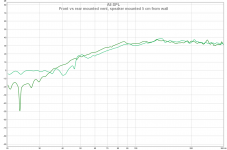 Spherical speaker - SEAS Coax - front vs rear mounted vent, speaker mounted 5 cm from wall.png76 KB · Views: 696
Spherical speaker - SEAS Coax - front vs rear mounted vent, speaker mounted 5 cm from wall.png76 KB · Views: 696 -
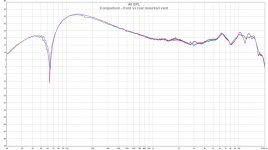 Spherical speaker - SEAS Coax - Nearfield measurement - front vs rear mounted vent, speaker moun.jpg138.7 KB · Views: 202
Spherical speaker - SEAS Coax - Nearfield measurement - front vs rear mounted vent, speaker moun.jpg138.7 KB · Views: 202 -
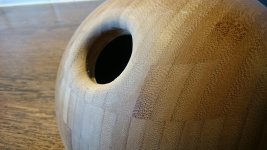 DSC_0431.jpg659 KB · Views: 306
DSC_0431.jpg659 KB · Views: 306 -
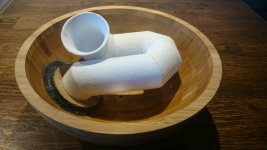 DSC_0440.jpg601.5 KB · Views: 356
DSC_0440.jpg601.5 KB · Views: 356 -
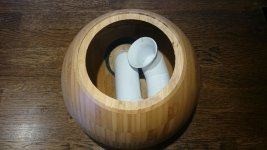 DSC_0443.jpg701.4 KB · Views: 370
DSC_0443.jpg701.4 KB · Views: 370 -
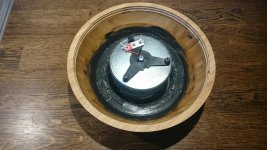 DSC_0445.jpg844.8 KB · Views: 364
DSC_0445.jpg844.8 KB · Views: 364 -
 DSC_0450.jpg623.6 KB · Views: 386
DSC_0450.jpg623.6 KB · Views: 386
Final adjustments and measurments of the surround speaker - results
So I've made the final adjustments on the surround speaker (20 cm IKEA bowl speaker with Seas coax). Fine adjustments on the vent and on the filter (slightly dampened the tweeter) after several hours of playing. The speaker now sounds as good as it can and the measurements shows the speaker itself is tuned correctly. Next step is of course to measure the room but that will have to wait until all speakers are ready and mounted. It feels good to know it's now ready and just to build the others in parallel (else it will take long time to build one after the other and maybe never finish them 😱).
So I've made the final adjustments on the surround speaker (20 cm IKEA bowl speaker with Seas coax). Fine adjustments on the vent and on the filter (slightly dampened the tweeter) after several hours of playing. The speaker now sounds as good as it can and the measurements shows the speaker itself is tuned correctly. Next step is of course to measure the room but that will have to wait until all speakers are ready and mounted. It feels good to know it's now ready and just to build the others in parallel (else it will take long time to build one after the other and maybe never finish them 😱).
Attachments
New challenge
I've started a new build project with the IKEA 28 cm bowls and Scan-Speak 18W/8545 together with the Scan-Speak 2905/9300 that I didn't used for a while. I really thought this wouldn't sound good together but now after completed the first I'm surprised, really. The bowls only offered 7,8 litres after the speaker (flush mounted), filters and damping materials had been installed.
I calculated the fB to 43Hz (to low with only 7,8 litres) on purpose to avoid any peak and still get it as deep as possible. The speaker itself can definately play lower but physics are physics 🙂. However, even though this affects the output it turned out to be a good compromise. The bass is extended without any peak, but of course it's far from perfect.
Since these bowls are made of bambu which is rather hard, which is good in one way but on the other hand doesn't dampen any vibrations either. Therefore the inside is covered with thick layer of rubber (found rubber spray - great stuff!) and the walls are covered with damping materials. I can't feel any vibrations from the cabinett (the spherical form effectively helps to eliminate it and the filter, speaker and some bracings inside transform the spherical inside to...not spherical and by that decreases the standing wave.
The bass reflex port is mounted on the outside, acting as a stand and enters the floor. I found this to be good because the sound from the vent (not by high air speed, 68 mm in inside diameter) but since it's a large and long pipe (due to small cabinette is needed to keep down the air speed but also because I wanted it to be long enough for a stand to acceptable listening height. The pipe is 68 cm long and the stand makes the woofer to approx 85 cm, the tweeter (mounted under the woofer on the pipe is at 65 cm height. This is not the optimal listening position but I have compensated this by the offset between the woofer and the tweeter to give a slight angle (2-3 degress) to perfect listening position at just over 1 m height, 3 meters away.
I could hear some tones from the vent that shouldn't be heard so I have tried with different amount of filling materials in the vent with very positive outcome to the sound but again to the cost of effeciency. The surprising measurement results from this is a deeper and a cleaner straighter frequency responce curve, interesting (First measurment picture where blue curve represents with filling int the vent and purple without). The bass sounded also dryer and more controlled. Will definately test this further when both speakers are built.
I attache some pictures and will keep you posted. Ps. the speaker are far from finished but the first listening and measurments looks promising.
I've started a new build project with the IKEA 28 cm bowls and Scan-Speak 18W/8545 together with the Scan-Speak 2905/9300 that I didn't used for a while. I really thought this wouldn't sound good together but now after completed the first I'm surprised, really. The bowls only offered 7,8 litres after the speaker (flush mounted), filters and damping materials had been installed.
I calculated the fB to 43Hz (to low with only 7,8 litres) on purpose to avoid any peak and still get it as deep as possible. The speaker itself can definately play lower but physics are physics 🙂. However, even though this affects the output it turned out to be a good compromise. The bass is extended without any peak, but of course it's far from perfect.
Since these bowls are made of bambu which is rather hard, which is good in one way but on the other hand doesn't dampen any vibrations either. Therefore the inside is covered with thick layer of rubber (found rubber spray - great stuff!) and the walls are covered with damping materials. I can't feel any vibrations from the cabinett (the spherical form effectively helps to eliminate it and the filter, speaker and some bracings inside transform the spherical inside to...not spherical and by that decreases the standing wave.
The bass reflex port is mounted on the outside, acting as a stand and enters the floor. I found this to be good because the sound from the vent (not by high air speed, 68 mm in inside diameter) but since it's a large and long pipe (due to small cabinette is needed to keep down the air speed but also because I wanted it to be long enough for a stand to acceptable listening height. The pipe is 68 cm long and the stand makes the woofer to approx 85 cm, the tweeter (mounted under the woofer on the pipe is at 65 cm height. This is not the optimal listening position but I have compensated this by the offset between the woofer and the tweeter to give a slight angle (2-3 degress) to perfect listening position at just over 1 m height, 3 meters away.
I could hear some tones from the vent that shouldn't be heard so I have tried with different amount of filling materials in the vent with very positive outcome to the sound but again to the cost of effeciency. The surprising measurement results from this is a deeper and a cleaner straighter frequency responce curve, interesting (First measurment picture where blue curve represents with filling int the vent and purple without). The bass sounded also dryer and more controlled. Will definately test this further when both speakers are built.
I attache some pictures and will keep you posted. Ps. the speaker are far from finished but the first listening and measurments looks promising.
Attachments
-
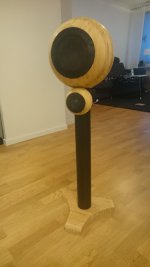 DSC_0493.jpg254.6 KB · Views: 447
DSC_0493.jpg254.6 KB · Views: 447 -
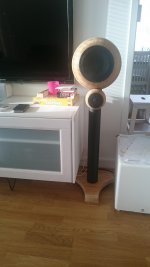 DSC_0497.jpg269.3 KB · Views: 433
DSC_0497.jpg269.3 KB · Views: 433 -
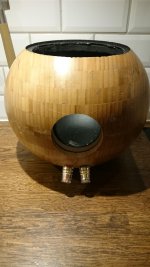 DSC_0509.jpg383.3 KB · Views: 375
DSC_0509.jpg383.3 KB · Views: 375 -
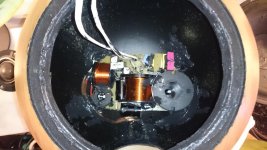 DSC_0512.jpg745.7 KB · Views: 428
DSC_0512.jpg745.7 KB · Views: 428 -
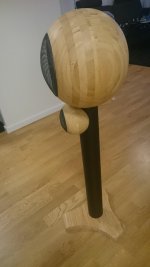 DSC_0494.jpg289.2 KB · Views: 404
DSC_0494.jpg289.2 KB · Views: 404 -
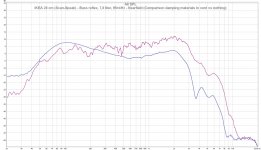 IKEA 28 cm (Scan-Speak) - Bass reflex, 7,8 liter, fB=4Hz - Nearfield speaker comparison.jpg157.2 KB · Views: 371
IKEA 28 cm (Scan-Speak) - Bass reflex, 7,8 liter, fB=4Hz - Nearfield speaker comparison.jpg157.2 KB · Views: 371 -
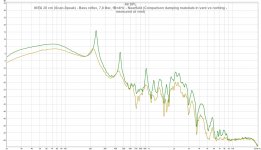 IKEA 28 cm (Scan-Speak) - Bass reflex, 7,8 liter, fB=4Hz - Nearfield vent comparison.jpg166.1 KB · Views: 256
IKEA 28 cm (Scan-Speak) - Bass reflex, 7,8 liter, fB=4Hz - Nearfield vent comparison.jpg166.1 KB · Views: 256 -
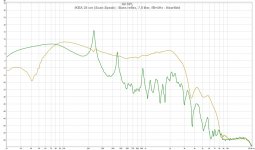 IKEA 28 cm (Scan-Speak) - Bass reflex, 7,8 liter, fB=4Hz - Nearfield.jpg161.7 KB · Views: 234
IKEA 28 cm (Scan-Speak) - Bass reflex, 7,8 liter, fB=4Hz - Nearfield.jpg161.7 KB · Views: 234
- Home
- Loudspeakers
- Multi-Way
- Ikea spherical speakers, first build done.
![DSC_0126[1].jpg](/community/data/attachments/473/473311-2a935b2fd0c595ea2e9dafe1dcab3529.jpg?hash=KpNbL9DFle)
![DSC_0133[1].jpg](/community/data/attachments/473/473336-ef19011ca2c2558c15c85b2f03cc6072.jpg?hash=7xkBHKLCVY)
![DSC_0135[1].jpg](/community/data/attachments/473/473387-1cf1ebd451c474f28c9b9a6991e9a55e.jpg?hash=HPHr1FHEdP)
